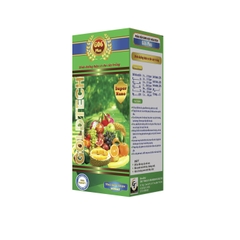Filter by
Goldtech Bioorganic fertilizer G05
specialized for MEDICINAL PLANTS
INGREDIENTS: OM: 23%, N: 7%; P2O5: 3%; K2O: 8%; S: 2%; Mg: 0.5%; Humic: 2.5%; Fe: 1213ppm; Zn: 1517ppm; Cu: 1311ppm; B: 2687ppm; Mn: 1925ppm; Mo: 339ppm; Co: 94ppm
BENEFITS:
- Make land reclamation, increase soil fertility and detoxifies soil toxicity;
- Help medicinal plants grow well, produce many roots and tubers;
- Enhance resistance to some fungal diseases, minimize appearance of tuber rot and root rot, increase flower and fruit setting rate;
- Enhance tolerance to hoarfrost, waterlogging, saline soil, drought, waterlogged saline soil…;
- Increase content of nutrients and medicinal compounds accumulated in particular parts of various medicinal plants;
- Increase the crop yield, lengthen plant longevity;
- Minimize utilization of inorganic fertilizers and plant protection drugs;
- Gain high – quality medicinal plants meeting export standards.
use instructions:
I. GINSENG
1. Seeding
Mixing instructions:
- Pouring: Mix a 2ml fertilizer bottle with 10 L of water to pour onto root.
- Spraying: Mix a 2ml fertilizer bottle with 18 – 20 L of water, spraying and making sure all stems and leaves get deeply wet.
Seeding and Care instructions:
- Seeding into nursery bags: Nursery bags D = 9 – 12cm, put seeds into a 2-cm-deep hole of the nursery bags. After that, cover surfaces of the nursery bags before continually cover the surfaces with a layer of rice husk. Moisturizing the bags regularly by watering.
- Seeding directly on nursery beds: Make soil porous, then apply basal compost by or slit the beds into horizontal slits 3 – 4 cm deep and 7 – 10 cm large and sow seeds in each the slit with the distance 5 cm between seeds and density 200 seeds/ m2. After that, cover the beds with sand and 1 layer of rice husk; maintain moisture for nursery beds.
Notes:
- Soaking the seeds: Mix 2ml of the G05 fertilizer with 10 liters of water and soak the seeds in this solution in 5 hours before lifting seedlings from nursery beds and incubate them into wet covers in 3 days.
- It will take 110 days for germination.
- When the seedlings are approximately 5 – 7 cm high, transplant them directly on farm.
- Seeding should be conducted from the end of October to November lunar calendar.
2. Planting and caring for ginseng
Mixing instructions:
- Pouring: Mix 2ml the fertilizer with 10L of water.
- Spraying: Mix 2ml the fertilizer with 20L of water, spray the mixture onto leaves, stems and make sure they get fully wet.
a. Planting
- Remove the seedlings from the bags carefully not to break the roots. Place them in holes 10 – 12 cm deep dug in the plantation and cover the holes with a light layer of soil. Not to let the holes be stagnant causing rotten bulbs. When the seedlings are 10 cm high, you need to take care of them regularly by spading carefully to avoid affecting roots and stems.
- Basal application comprises: 2 – 3 hundredweight of manure or compost, 12 – 15 kilogram of super phosphate, 12 – 15 kilogram of NPK (15-15-15), 4 – 5 kilogram of Urea. Combining to spray the G05 fertilizer (mix 5ml of the fertilizer with 25 liters of water) to spray the whole plantation.
- Topdressing ginseng sprouts: Mix 2ml of the fertilizer with 25 liters of water and spray this solution on the surface of beds extensively when ginsengs sprout. Cover the beds with a layer of fertile soil, spray once every 10 days. When seedlings produce true leaves, spray the solution once every 10 – 15 days.
b. Caring for ginseng
- It is required to cover nursery beds with gently mulch (e.g. straw), which supports producing high-quality products as well as facilitates caring process. The straw layers are at least 3 – 4 cm thick in order to keep the plants be warm in the winter. Need to maintain moisture for plants but not be too humid in a long time, which result in rotten ginseng roots. Build farm water drainage ditches to prevent rain from overflowing into ginseng plantation. Need to drain water completely out of beds after raining.
- Weeding diligently by hand and dredging the furrows, let ginseng plants sprout in March and ensure water them to maintain moisture and avoid drought in April and May.
- Clean the plantation before June, dredging the furrows and drainage system.
- In the end of rain season, keep dredging the furrows and weeding. Then let ginseng plants be in dormant stage.
- Spray the G05 fertilizer once every 20 – 25 days in order to help ginseng grow strongly; restrict fungal diseases; increase its therapeutic constituents; decrease caring time for it; help harvesting season come soon
II. OTHER MEDICINAL PLANTS
1. Leafy medicinal herbs
Mixing instructions: Mix 2ml of the fertilizer with 20 liters of water. Spray this solution on stems and leaves extensively.
Care instructions:
It is required to spray once every 7 – 10 days when trees produce 3 – 5 true leaves. This helps the plants to grow fast and produce many green leaves; minimizes diseases or pests; especially, increases tolerant ability of the plants to unfavorable weather conditions (coldness, hoarfrost, acid rain, drought, flood,…) and minimize some diseases such as: downy mildew, anthracnose, powdery mildew, wilt and yellow leaves....
Notes: When pests or diseases appear, mixing the G05 fertilizer together with plant protection drugs (except herbicide) according to instructions will help the plants recover quickly.
2. Fruit-bearing medicinal plants
Mixing instructions:
- Pouring: Mix 2ml of the fertilizer with 8 – 10 liters of water.
- Spraying: Mix 2ml of the fertilizer with 16 – 20 liters of water and spray the mixture on shoot system and make sure that it gets fully wet.
Care instructions:
- The 1st time: Mix 2ml of the G05 fertilizer with 20 liters of water. Spray the mixture on stems and leaves after 3 – 5 days of planting to help the plants grow fast, produce root system quickly (in relation to seeding into nursery bags).
- The 2nd time: Mix 2ml of the fertilizer with 16 – 18 liters of water. Spray this solution on roots, stems and leaves when the plants start to bloom. This helps them grow fast and produce many female flowers. It should be sprayed in the late afternoon to ensure the ability of pollinating.
- The 3rd time: Spray roots when the plants are flowering and fruiting to increase the percentage of fruit set; increase their resistance ability to pests and diseases; prevent flowers and premature fruits from being dropped (avoid spraying directly on flowers to prevent them from being dropped).
Routine care: After setting fruits, increase the number of times for pouring the mixture to roots and decrease the number of times for spraying it onto stems and leaves. Pour it to roots once every 15 – 20 days; Spray it once every 7 – 10 days onto stems and leaves and make sure they get fully wet to make fruits be bigger and get high quality.
3. Edible tuber-bearing medicinal plants
Mixing instructions:
- Pouring: Mix 2ml of the fertilizer with 16 – 20 liters of water.
- Spraying: Mix 2ml of the fertilizer with 8 – 10 liters of water, spray the mixture onto stems and leaves and make sure that they get fully wet.
Care instructions:
- The 1st time: Mix 2ml of the fertilizer with 20 liters of water. Spray this solution on stems and leaves when trees produce 3-5 true leaves to help root system to grow fast.
- The 2nd time: Mix 2ml of the fertilizer with 16 – 18 liters of water. Spray this solution on stems and leaves extensively after planting; spray once every 5 – 7 days to help the plants grow fast; their leaves be bigger; produce more tubers (in relation to the plants producing many tubers such as: ginger, saffron,…).
Routine care: From the 3rd time onwards, spray once every 7 – 10 days. Do that until before harvesting 7 – 10 days to help the tubers become big quickly; increase nutrient content accumulated in tubers.
NOTES:
- Before applying the fertilizer, should water to increase soil humidity then plants will uptake well and recover quickly.
- Can be mixed with plant production drugs (except herbicide).
- Keep out of reach of children, preserved in a cool dry place.
- Shake well before using.
- Expiry date is printed on bottom of the bottle.







